 Shri Panch Mahamangalpuri Dham is an esteemed temple of the Pranami Sampradaya, a spiritual tradition rooted in monotheism, equality and religious tolerance. This sect exclusively venerates the child form of Lord Krishna, reflecting its profound reverence for innocence and divinity. This temple holds a unique position as a prominent Jagani centre within the Pranami tradition. The term Jagani translates to self-awakening, spiritual upliftment, or the harmonious union of the soul with the Supreme Being. Shri 5 Mahamangalpuri Dham is historically significant as the origin point of the Jagani Yatra (spiritual awakening journey), initiated by the founder of the Pranami faith, Mahamati Prannath. It was also here that Mahamati Prannath’s coronation (referred to as Gadi-Abhishek) took place, marking this temple as a cornerstone of the faith. Known colloquially as the Shri Krishna Pranami Mota Mandir, this temple serves as a sacred hub of devotion and spiritual awakening for followers of the Pranami Sampradaya.
Shri Panch Mahamangalpuri Dham is an esteemed temple of the Pranami Sampradaya, a spiritual tradition rooted in monotheism, equality and religious tolerance. This sect exclusively venerates the child form of Lord Krishna, reflecting its profound reverence for innocence and divinity. This temple holds a unique position as a prominent Jagani centre within the Pranami tradition. The term Jagani translates to self-awakening, spiritual upliftment, or the harmonious union of the soul with the Supreme Being. Shri 5 Mahamangalpuri Dham is historically significant as the origin point of the Jagani Yatra (spiritual awakening journey), initiated by the founder of the Pranami faith, Mahamati Prannath. It was also here that Mahamati Prannath’s coronation (referred to as Gadi-Abhishek) took place, marking this temple as a cornerstone of the faith. Known colloquially as the Shri Krishna Pranami Mota Mandir, this temple serves as a sacred hub of devotion and spiritual awakening for followers of the Pranami Sampradaya.
The Pranami Sampradaya, also known as the Nijanand Sampradaya, was founded by Swami Devchandra, born on 11 October 1581 in Umarkot, Sindh. This spiritual tradition emphasises monotheism and unityand its followers expressed their mutual respect and bond by greeting each other with Pranam (a respectful salutation). This practice led to them being called Pranamis.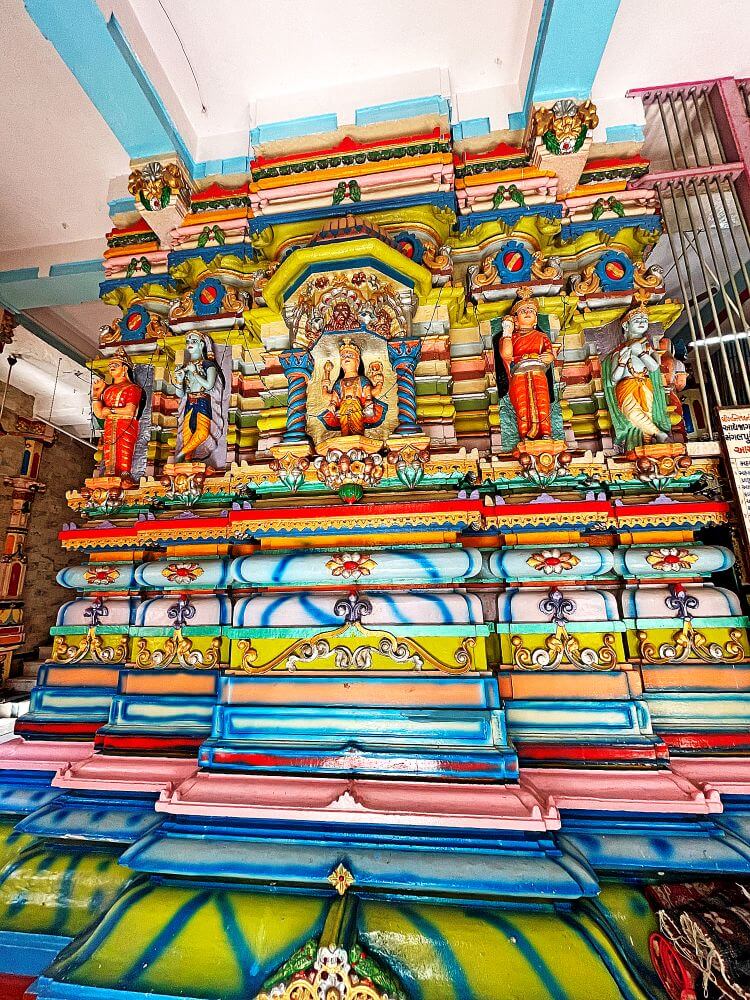 Mahamati Prannath, originally named Mehrraj Thakur, played a pivotal role in broadening the reach and scope of the Pranami tradition. Born on 7 October 1618 in Jamnagar, Gujarat, Mehrraj was the son of Keshav Thakur, the chief minister of Jamnagar state. At the age of 12 years, 2 months and 10 days, Mehrraj met Swami Devchandra. During this meeting, Swami Devchandra initiated Mehrraj into the spiritual practice by imparting the Nijanam Taratam mantra. Inspired by the resolution, Sukh Sheetal Karoon Sansar (to bring peace and comfort to the world), Mehrraj adopted the name Mahamati Prannath and established the Sundarsath Sangha, a community devoted to spiritual awakening and universal love. Followers of the Pranami Sampradaya came to be known as Sundarsath.
Mahamati Prannath, originally named Mehrraj Thakur, played a pivotal role in broadening the reach and scope of the Pranami tradition. Born on 7 October 1618 in Jamnagar, Gujarat, Mehrraj was the son of Keshav Thakur, the chief minister of Jamnagar state. At the age of 12 years, 2 months and 10 days, Mehrraj met Swami Devchandra. During this meeting, Swami Devchandra initiated Mehrraj into the spiritual practice by imparting the Nijanam Taratam mantra. Inspired by the resolution, Sukh Sheetal Karoon Sansar (to bring peace and comfort to the world), Mehrraj adopted the name Mahamati Prannath and established the Sundarsath Sangha, a community devoted to spiritual awakening and universal love. Followers of the Pranami Sampradaya came to be known as Sundarsath.
After the passing of Guru Devchandra, leadership of the sect was inherited by his son, Bihari, who was known for his authoritarian nature. Bihari’s style of leadership caused significant discontent among the community, including differences with Mahamati Prannath. Over time, devotees requested Prannath to establish a separate leadership to guide the faith. In response, in 1672, Prannath raised the flag of the faith at Panchmahamangalpuri Dham on the banks of the Tapi River in Surat, marking the establishment of an independent lineage within the Pranami tradition. At the time of Prannath’s establishment of the new seat, Surat was under the rule of Mughal Emperor Aurangzeb. 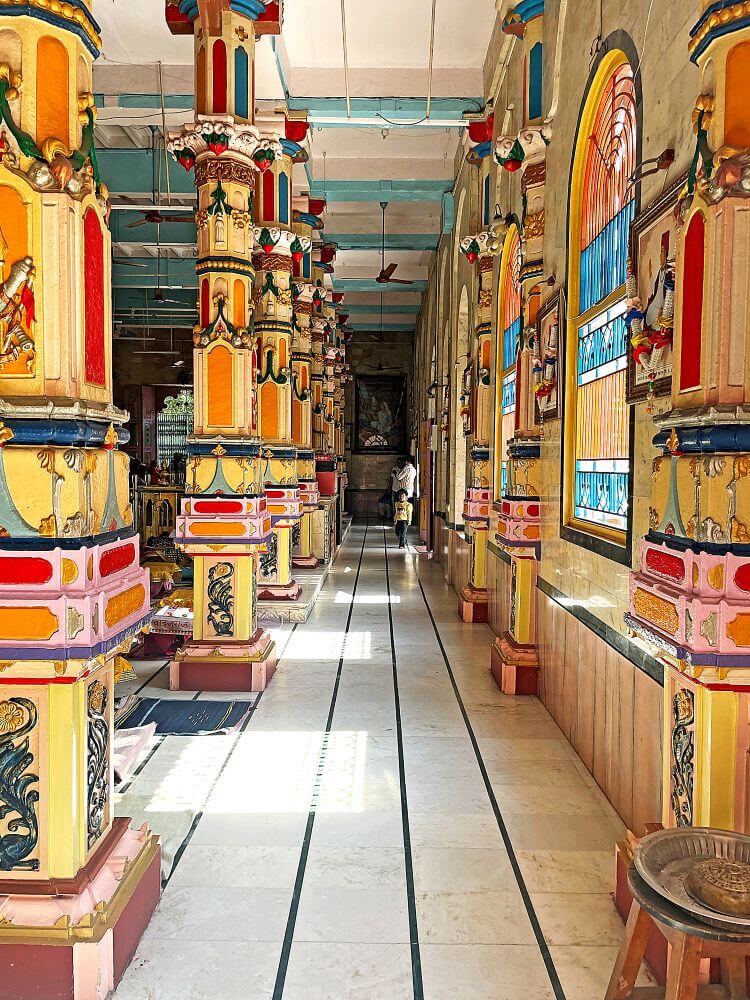 This period was marked by political turbulence, as two years prior, Chhatrapati Shivaji Maharaj had launched his second attack on Surat.
This period was marked by political turbulence, as two years prior, Chhatrapati Shivaji Maharaj had launched his second attack on Surat.
Prannath resided at Panchmahamangalpuri Dham for 17 months. It was during this time that he was conferred the title Mahamati (The Great Thinker) and the name Prannath (Lord of Life), symbolising his spiritual authority and enlightenment. While at the Dham, he composed 507 chaupais (poetic verses) across 12 chapters of Shri Kalashvani, a foundational scripture of the Pranami Sampradaya. This work is revered for its deep spiritual insights and teachings. It was also from this sacred site that Prannath initiated the Jagani Yatra (Journey of Spiritual Awakening), a mission to spread the principles of self-realisation and divine unity. Due to these significant events, Panchmahamangalpuri Dham is regarded as a holy site within the Pranami tradition.
The temple is situated on a large tract of land in the Saiyadwada area and features a grand gateway reminiscent of a majestic palace. The entrance is adorned with an exquisite mural of Radha and Krishna on its upper section, symbolising the temple’s devotion to Lord Krishna. Inside the gateway, there are beautifully painted, larger-than-life depictions of Sadguru Devchandra Maharaj and Prannath Maharaj, the revered figures of the Pranami Sampradaya.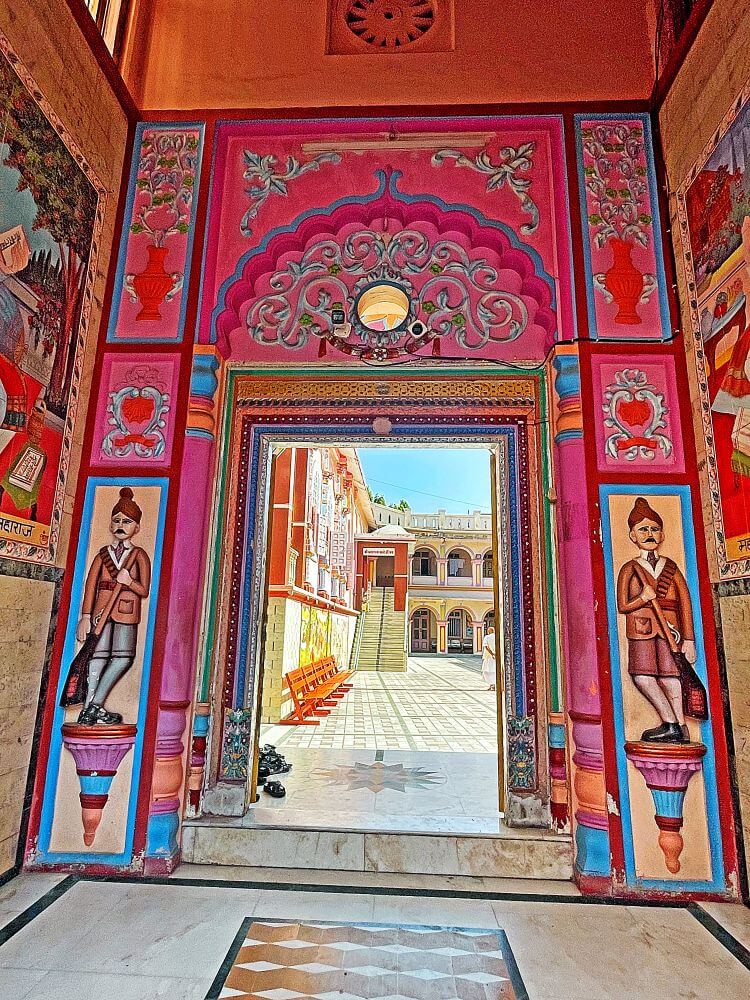 The gateway itself is an artistic marvel, showcasing intricate carvings and vibrant colours that reflect traditional craftsmanship.
The gateway itself is an artistic marvel, showcasing intricate carvings and vibrant colours that reflect traditional craftsmanship.
On either side of the inner doorframe, there are striking sculptures of Dwarapalas (gatekeepers). What sets these sculptures apart is their distinctive design—they are modelled after British-era soldiers. These gatekeepers are depicted wearing boots, short trousers and a traditional angarakha (jacket), with a bandolier of ammunition strapped across their chest, a turban on their head and holding rifles. While the Pranami temple was originally established during the Shivaji era, the design and style of the gateway suggest that it was constructed in a later period, as evidenced by the British colonial influence in the attire and styling of the Dwarapalas.
Upon entering the temple, visitors are greeted by a spacious courtyard at the centre of the complex. At the heart of this courtyard stands a tall flagpole, symbolising the spiritual prominence of the site. Surrounding the courtyard on all four sides are two-storey buildings, adding a sense of symmetry and grandeur to the complex.
On the right side of the courtyard, elevated on a platform approximately 5-6 feet high, stands the Pranami Temple. The platform is adorned with a stunning mural depicting the Rasleela of Radha and Krishna and the coronation ceremony (Gadi Abhishek) of Mahamati Prannath. 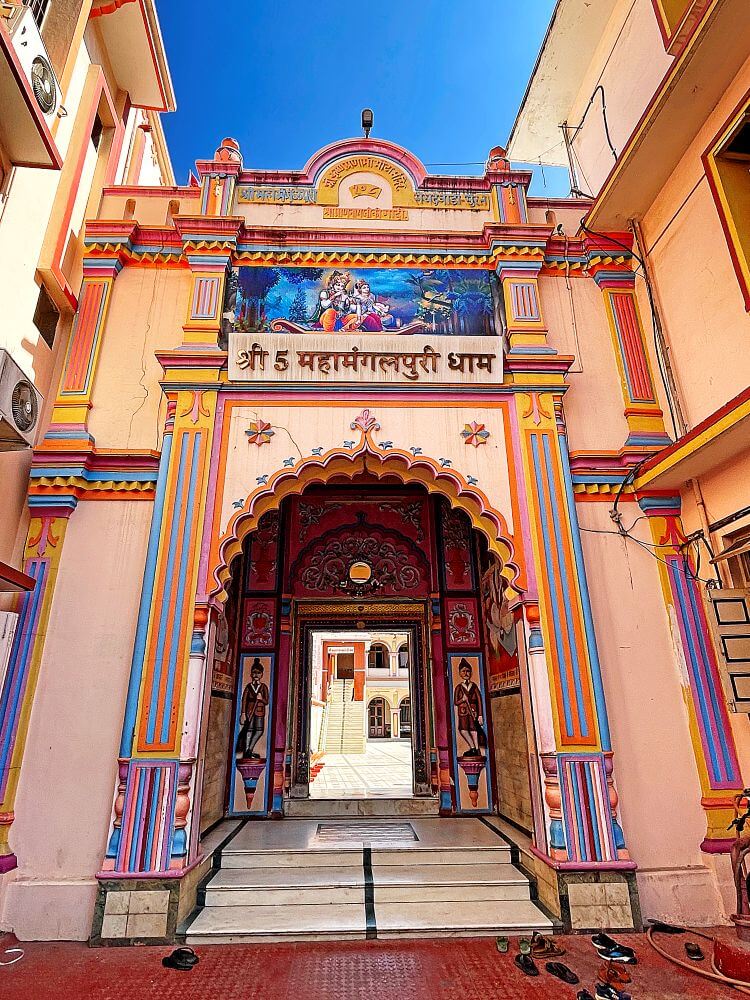 The temple itself is structured in a traditional manner, consisting of a small porch (Mukhamandap), a spacious assembly hall (Sabhamandap) and the sanctum sanctorum (Garbha-Griha).
The temple itself is structured in a traditional manner, consisting of a small porch (Mukhamandap), a spacious assembly hall (Sabhamandap) and the sanctum sanctorum (Garbha-Griha).
The roof of the temple features a tall spire (Shikhar) built in the Nagara style of architecture, characterised by its curvilinear design and intricate ornamentation. The spire follows the Urushringa pattern, with miniature spires adorning the main structure. Below the main spire, small niches (Devkoshtaka) are present on all four sides, each containing carvings of deities. On the front side, a lion sculpture is prominently displayed, symbolising strength and protection. At the apex of the spire, atop a rounded Amalaka (a fluted, circular element), rests a large, ornate Kalash (sacred pot), completing the pinnacle of the temple.
The temple features two simple porches (Mukhamandaps), from which visitors ascend 12 steps to enter the assembly hall (Sabhamandap). The Sabhamandap has a flat ceilingand its walls are adorned with colourful stained-glass windows on either side, adding a serene and vibrant atmosphere to the space. The grandeur of the Sabhamandap is further enhanced by intricately carved and painted stone pillars that exhibit exceptional craftsmanship. Along the walls of the hall,  portraits of prominent Acharyas (spiritual leaders) who succeeded Mahamati Prannath at Panchmahamangalpuri Dham are displayed, including Govardhanacharya Maharaj, Shyamaldas Maharaj, Amareshwardas Maharaj and Mulchandradas Maharaj.
portraits of prominent Acharyas (spiritual leaders) who succeeded Mahamati Prannath at Panchmahamangalpuri Dham are displayed, including Govardhanacharya Maharaj, Shyamaldas Maharaj, Amareshwardas Maharaj and Mulchandradas Maharaj.
At the far end of the Sabhamandap, to the left, stands a small sanctum (Devli) crowned with a dome-shaped spire and a sacred Kalash. This sanctum holds the Gadi (seat) of Mahamati Prannath. The sanctum features an ornate Makhar (canopy), richly adorned with golden cladding and detailed carvings. Within this canopy rests two gold, jewel-encrusted crowns, placed reverently on a Gadi. Above the Gadi, carvings depict Mahamatya Prannath and his consort, Tejkunwar, also known as Baijuraj Maharaj. Directly in front of the Gadi, two Chaurangs (low ceremonial platforms), also decorated with golden cladding, house two sacred Padukas (footwear).
The main sanctum of the temple has a steel-barred wall at the front, adorned with colourful portraits of Radha-Krishna, as well as Swami Devchandra Maharaj and Pran Nath Maharaj. The outer walls of the sanctum, made of stone, feature intricately carved sculptures of Bansidhar Krishna (Krishna holding a flute), Lord Vishnuand various divine attendants (devsevika). The ornate carvings and vibrant artwork on these walls enhance their beauty and also reflect the ancient heritage of the temple.
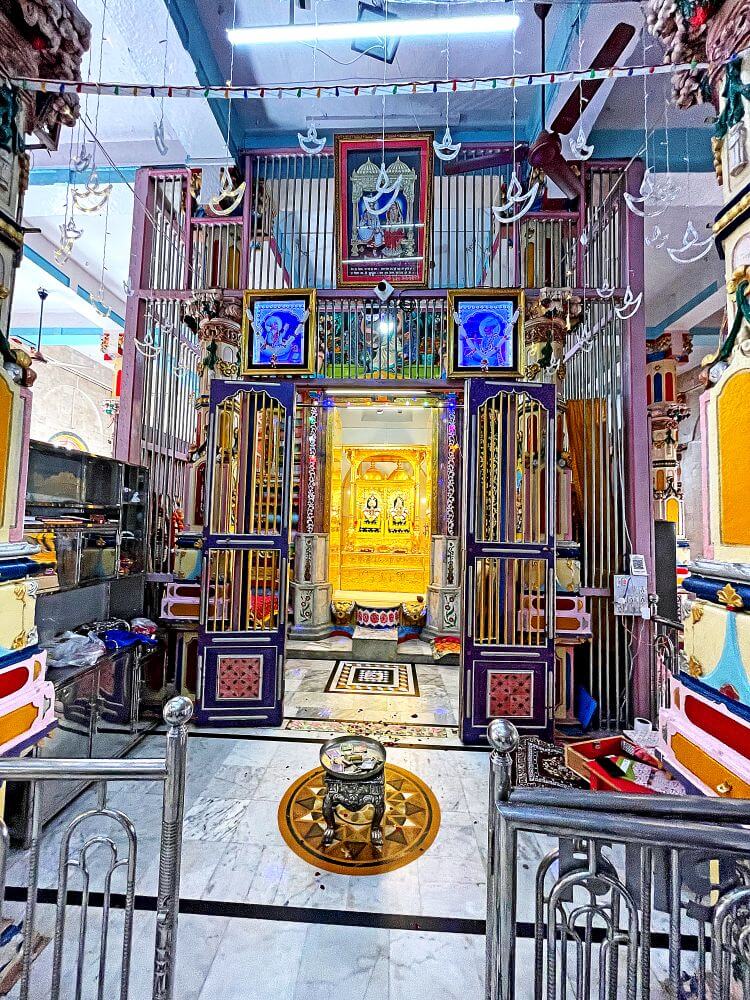 Inside the sanctum, there is a gold-plated canopy (makhar), flanked by two golden elephants (gajaraj) positioned in front of the canopy’s columns. The canopy houses two elevated cushions, topped by a small dome-shaped spire. The sanctum’s focal point is the sacred presence of Radha and Krishna. In the Pranami tradition, idols are not worshipped. Instead, the ‘Tartamvani’ scripture, considered the holy embodiment of Radha-Krishna, is venerated. The scripture is enshrined in the canopy, adorned with golden crowns, ornate garmentsand flower garlands, symbolising the divine presence of Radha-Krishna in the form of the sacred text.
Inside the sanctum, there is a gold-plated canopy (makhar), flanked by two golden elephants (gajaraj) positioned in front of the canopy’s columns. The canopy houses two elevated cushions, topped by a small dome-shaped spire. The sanctum’s focal point is the sacred presence of Radha and Krishna. In the Pranami tradition, idols are not worshipped. Instead, the ‘Tartamvani’ scripture, considered the holy embodiment of Radha-Krishna, is venerated. The scripture is enshrined in the canopy, adorned with golden crowns, ornate garmentsand flower garlands, symbolising the divine presence of Radha-Krishna in the form of the sacred text.
The ‘Tartamvani’ scripture, also referred to as ‘Kuljam Swarup’, is a collection of 17 sacred texts. It is divided into three main sections: 1. Vedic Philosophy: Texts based on the principles of the Vedas. 2. Spiritual Teachings of the Quran and the Bible: A harmonious exploration of spiritual wisdom from these scriptures. And 3. Praise of Brahma in Its Purest Form: Texts glorifying the absolute and manifest form of Brahma. According to the Pranami tradition, ‘Kuljam Swarup’ is a guide for spiritual awakening, referred to as Jagani. Through Tartamvani, Pran Nath Maharaj proposed revolutionary ideas of monotheism, equalityand transcending religious divisions, including those between Hindus and Muslims. He proclaimed that the Vedas and the Quran share the same essence and speak of one universal God. 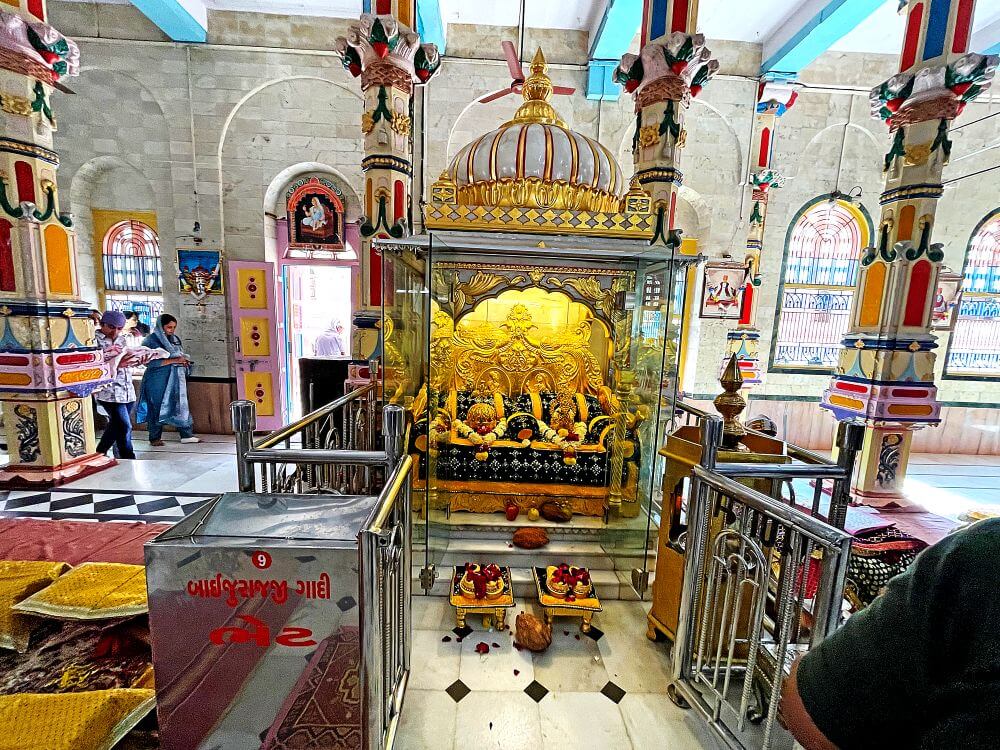 One of his profound verses illustrates this idea. It says, ‘Jo kuchh kahya Kateb ne, soyi kahya Ved; doo bande ek Sahib ke, par ladat bina paye bhed.’ Meaning: ‘What the Quran says is the same as what the Vedas proclaim; both are bound to the same Lord, yet people fight, unable to understand their unity.’ Pran Nath referred to these scriptures as ‘Ved Katebon ki yeh kunji’. Meaning: ‘Key to the Vedas and the Quran’. His teachings aimed to break barriers of caste, religionand societal divisions, encouraging humanity to see beyond differences and embrace the oneness of the divine.
One of his profound verses illustrates this idea. It says, ‘Jo kuchh kahya Kateb ne, soyi kahya Ved; doo bande ek Sahib ke, par ladat bina paye bhed.’ Meaning: ‘What the Quran says is the same as what the Vedas proclaim; both are bound to the same Lord, yet people fight, unable to understand their unity.’ Pran Nath referred to these scriptures as ‘Ved Katebon ki yeh kunji’. Meaning: ‘Key to the Vedas and the Quran’. His teachings aimed to break barriers of caste, religionand societal divisions, encouraging humanity to see beyond differences and embrace the oneness of the divine.
The King of Bundelkhand, Chhatrasaland his daughter Mastani were followers of the Pranami sect. Not only that, but Chhatrasal’s name is included in the “Panchkam” of the Pranami sect. According to historian D. G. Godse, the “Panchkam” comprises Shri Krishna, Muhammad, Devchandra, Pran Nathand Chhatrasal. Inspired by Guru Mahamati Pran Nath and Chhatrapati Shivaji Maharaj, Chhatrasal established an independent kingdom in Bundelkhand. Historical records also mention that Chhatrasal met Shivaji Maharaj. The ordination of Mahamati Pran Nath took place at the Pranami temple in Surat in 1672, the same year that Chhatrasal escaped from Diler Khan’s camp in Baglan and sought refuge with Shivaji Maharaj. At that time, Shivaji Maharaj encouraged Chhatrasal to establish his own independent kingdom.
Even Mahatma Gandhi’s mother, Putlibai, was a follower of the Pranami sect. Near Gandhi’s home in Porbandar, there was a residence of Swami Lal Das, a disciple of Pran Nath, which later became a Pranami temple. As a result, from an early age, the principles of the Pranami sect—truth, non-violenceand religious harmony—had a profound influence on Mahatma Gandhi. He even mentioned this in his autobiography.
In the Pranami sect, devotion to Krishna holds special significance. Followers of this sect believe that Sadguru Devchandra received the teachings of this sect directly from Lord Krishna. However, within this tradition, only the child form of Krishna (Bal Krishna) is worshipped. The temple celebrates Krishna Janmashtami with great enthusiasm and devotion.
